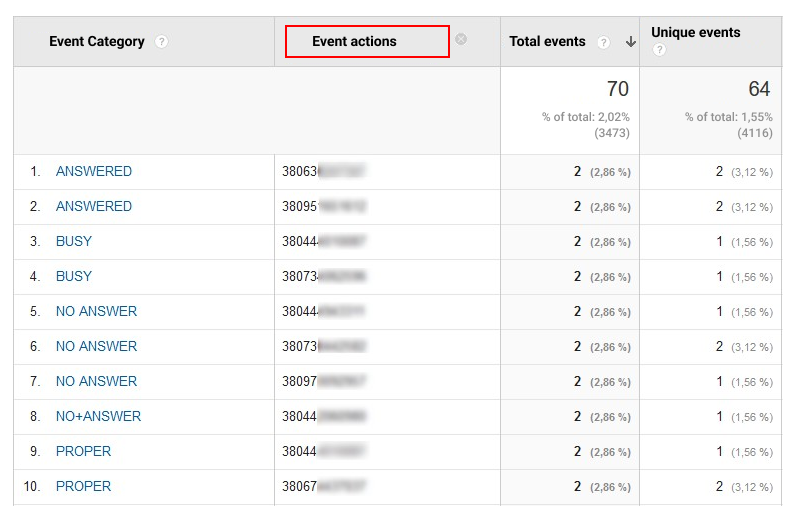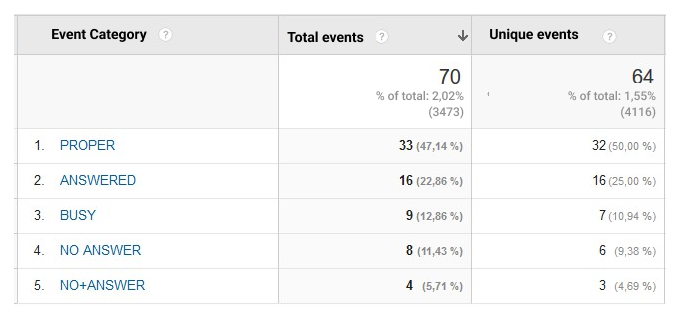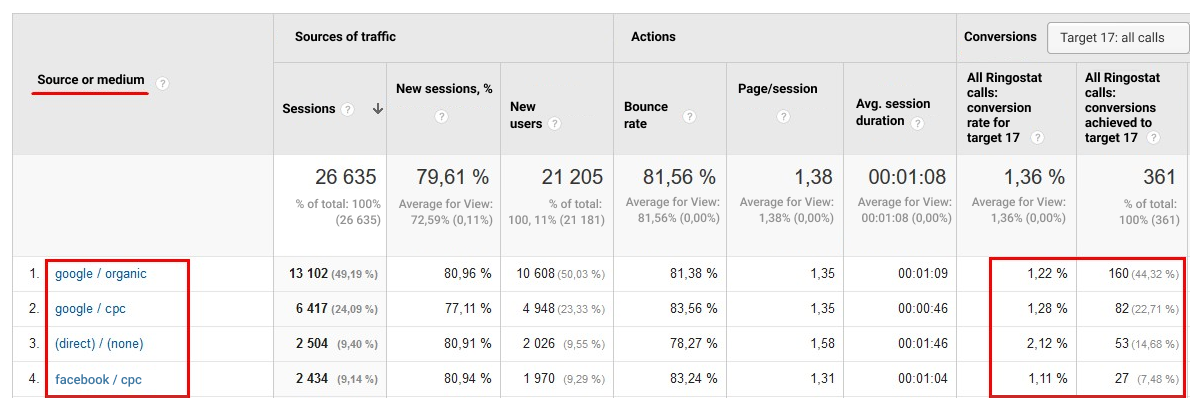Let’s continue talking about the reasons for the discrepancy between call tracking and other systems. In the previous blog post, I laid out the spread reasons for the mismatch in the number of calls. Today, I’m going to shed a little more light on Google Analytics.
Imagine a typical situation. The person comes to the website from advertising, sees the phone number and picks up the phone. Call tracking displays this call in the call log by attaching detailed data on call source. To learn more about this process read the post “What is call tracking?”.

If call tracking is integrated with Google Analytics, you may transfer the call data to this analytic system. However, there you may view another statistics.

On the left, you see call categories akin to the ones in call tracking and phone numbers. On the right, you notice additional options as an event and unique event. The number of events often differs from unique events. What does it mean for you? Why is call statistics changing when transferring to Google Analytics?
The point is call tracking and Google Analytics see calls in different ways. Web analytics system considers calls as events or goals and applies appropriate rules to them.
To get a better understanding of why the statistics may differ, let’s start with Google Analytics basics.
Session
A session is a group of user interactions with your website that take place within a given time frame.
There are three methods by which a session ends:
- after 30 minutes of inactivity;
- at midnight;
- if a user arrives via one campaign, leaves, and then comes back via a different campaign.
Mismatch in terms of Events
The user generates events by interacting with the website. Downloads, clicks and video plays are the examples of actions you might track as Events. These events are tracked within one user session on the website.
Google Analytics tracks calls or inquiries via callback widget as events that are transferred to its system by third-party service.
Due to integration with Ringostat, all calls from the website are transferred to Google Analytics as events. In the report Behaviour — Events — Top Events you may see categories of events depending on call status in Ringostat (proper, answered, repeated, failed etc).

The call in the call log is an event. That goes without saying. However, there’s one more definition of the unique event. The unique event is a user interaction with the site within one session. Here is where statistics mismatch appears. You may make a few phone calls within one session but Google Analytics won’t consider them as unique events.
Examples
- Jack makes a phone call to the company to order two pizzas. Later he understands that he wants to order one more. Jack calls again but doesn’t get the answer. What we see:
- in call tracking: two different calls — target and missed;
- in Google Analytics: two new unique events — because the call categories are different (PROPER and NO ANSWER).
- Jack gets the answer from contact center operator. Then he wants to clarify details and calls again in 15 minutes. What we see:
- in call tracking: two different target calls.
- in Google Analytics: two new events but only one of them is unique because both calls are PROPER.
Put it simply, two different calls for call tracking are just events with similar parameters for Google Analytics. If calls have the same category and happened within one session, they aren’t unique for Google Analytics.
Mismatch in terms of Goals
Actually, not many companies analyze calls as events. The more convenient way is to set up goals for certain activities.
A goal is a tool to track user behavior on the website. The goal may be set up for any actions (f.e. adding an item to the cart, subscription to the newsletter or submitting a contact information form).
It allows to analyze conversions in terms of completing the goal “Calls”.
You may set up a general goal for all categories of calls. Separately, you may set up a goal to track proper calls or unique first calls.

Pay attention
We don’t recommend to set up one goal for all calls. It’s like to track absolutely all website conversions. It would be better to set up separate goals for different call categories.
The goal within one session in Google Analytics can be achieved only once. All calls from a user within one session are considered as one goal completion not depending on the call category. For instance, if a user didn’t get the answer from you twice, only one goal “A missed call” will be considered.
Example
Charles set up a goal for calls via call back. Client ordered a phone call but nobody called him back. After 10 minutes he called again and contact center operator answered.
In call tracking it will be two different calls with different categories. In Google Analytics these calls will be considered as one goal completion.
To sum up
- Google Analytics and call tracking count phone calls differently. The reason is Google Analytics is designed to analyze online conversions but not calls.
- There can be several calls within one session. For example, two answered calls, one missed, a few calls via the callback. The Google Analytics algorithms count them differently. Therefore, you may get the mismatch between call tracking and Google Analytics.
- All calls are transferred to GA as events. However, they aren’t always considered as unique events. It depends on the session and event category (call status: missed, answered, etc).
- The number of calls in call tracking and unique events in Google Analytics differs from the number of goal completions. Several phone calls within one session can be different events but counted as one goal completion.
The discrepancy in call statistics between call tracking and Google Analytics is a spread situation because both services are created for different goals. Call tracking logs incoming calls and Google Analytics processes them using own rules. Thus, both systems supplement each other and allow to analyze calls and their advertising sources from different perspectives.
Learn more about how to set up goals for calls and which goals matter for your business topic.

